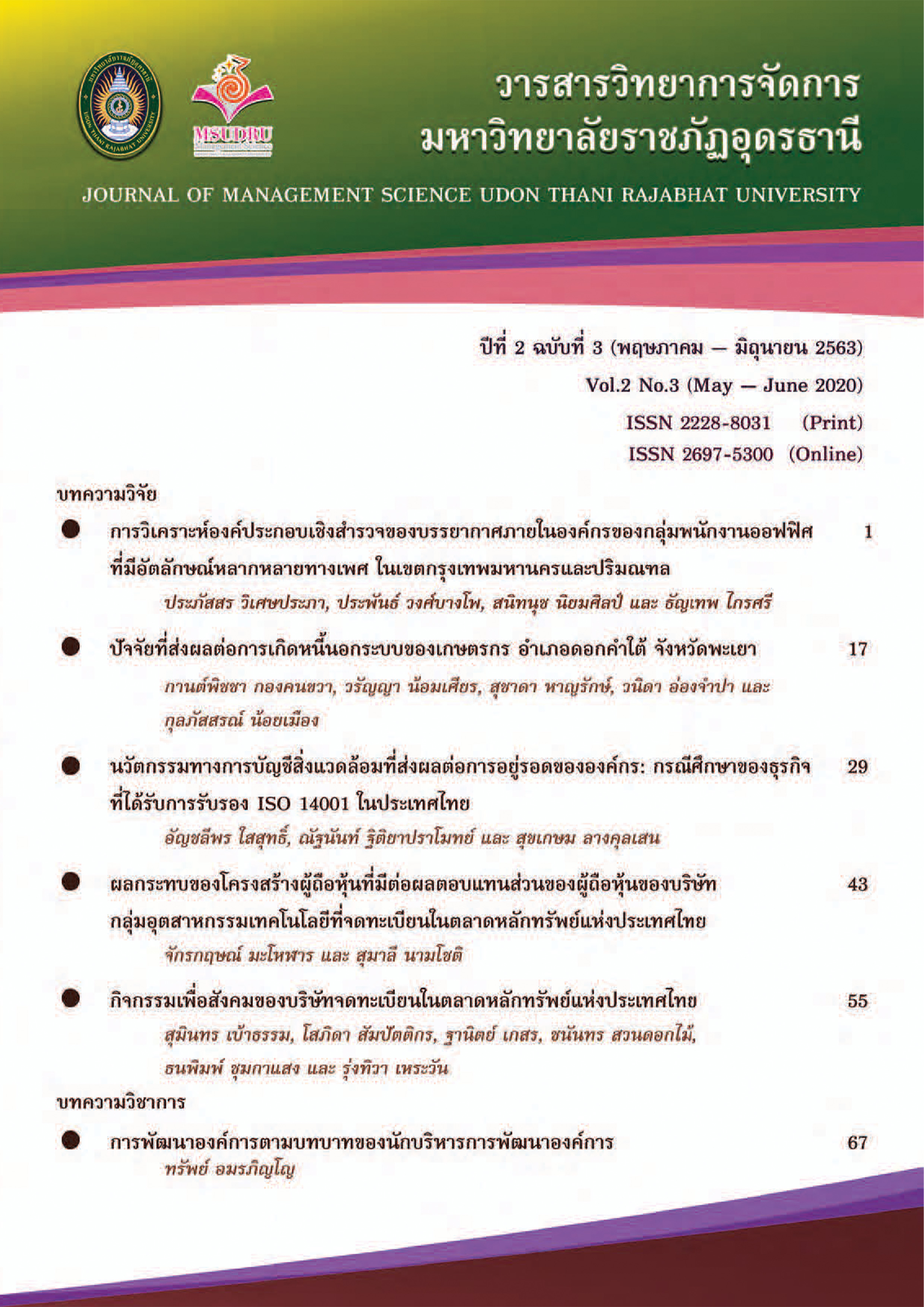การวิเคราะห์องค์ประกอบเชิงสำรวจของบรรยากาศภายในองค์กรของกลุ่มพนักงานออฟฟิศ ที่มีอัตลักษณ์หลากหลายทางเพศ ในเขตกรุงเทพมหานครและปริมณฑล
Main Article Content
บทคัดย่อ
งานวิจัยนี้มีวัตถุประสงค์ เพื่อวิเคราะห์องค์ประกอบเชิงสำรวจของบรรยากาศภายในองค์กรของกลุ่มพนักงานออฟฟิศที่มีอัตลักษณ์หลากหลายทางเพศ (LGBT) ในเขตกรุงเทพมหานครและปริมณฑล โดยเก็บข้อมูลด้วยแบบสอบถามจากพนักงานออฟฟิศกลุ่ม LGBT จำนวน 400 ราย สุ่มตัวอย่างโดยไม่ใช้ความน่าจะเป็นแบบก้อนหิมะ (Snowball sampling) วิเคราะห์ข้อมูลด้วยสถิติเชิงพรรณนาและการวิเคราะห์องค์ประกอบเชิงสำรวจ พบว่า บรรยากาศภายในองค์กรสามารถจัดกลุ่มตัวแปรได้3 องค์ประกอบ ได้แก่ ความเป็นตัวตน (Fine) ความเป็นปรปักษ์ (Foe) และความเป็นมิตร (Friend) โดยทั้ง 3 องค์ประกอบ สามารถอธิบายความแปรปรวนของตัวแปรข้อค าถามทั้งหมด (Explain Variance - Cumulative) ได้ร้อยละ 50.55 และมีความน่าเชื่อถือผ่านเกณฑ์ที่ยอมรับได้ ทั้งนี้ องค์ประกอบความเป็นตัวตน สามารถอธิบายความแปรปรวนได้มากที่สุด รองลงมาคือ องค์ประกอบความเป็นปรปักษ์ และสุดท้ายคือ องค์ประกอบความเป็นมิตร
Article Details

This work is licensed under a Creative Commons Attribution-NonCommercial-NoDerivatives 4.0 International License.
บทความที่ได้รับการตีพิมพ์เป็นลิขสิทธิ์ของคณะวิทยาการจัดการ มหาวิทยาลัยราชภัฏอุดรธานี
ข้อความที่ปรากฏในบทความแต่ละเรื่องในวารสารวิชาการเล่มนี้
ไม่ใช่ความคิดเห็นและความรับผิดชอบของผู้จัดทำ บรรณาธิการ กองบรรณาธิการ และคณะวิทยาการจัดการ มหาวิทยาลัยราชภัฏอุดรธานี ความรับผิดชอบด้านเนื้อหาและการตรวจร่างบทความแต่ละเรื่องเป็นความคิดเห็นของผู้เขียนบทความแต่ละท่าน
References
ณรงค์กร มโนจันทร์เพ็ญ. (2561). ที่ไหนบ้างอนุญาตให้ ‘คู่รักเพศเดียวกัน’ สมรสกันได้อย่างถูกต้องตามกฎหมาย. สืบค้นเมื่อ 22 มิถุนายน 2563, จาก https://thestandard.co/legalized-same-sex-marriage-countries/
ธัญเทพ ไกรศรี และ ภควดี พัฒน์มณี. (2562). บรรยากาศภายในองค์การและความพึงพอใจในงานของกลุ่มพนักงานสำนักงานที่มีอัตลักษณ์หลากหลายทางเพศในเขตกรุงเทพมหานครและปริมณฑล. วารสารบริหารธุรกิจและสังคมศาสตร์ มหาวิทยาลัยรามคำแหง, 2(3), 73-87.
บุษกร สุริยสาร. (2557). อัตลักษณ์และวิถีทางเพศในประเทศไทย. กรุงเทพฯ: องค์การแรงงานระหว่างประเทศ.
สิรธันย์ วดีศิริศักดิ์. (2555). แนวทางในการพัฒนาความงามฉลาดทางวัฒนธรรมเพื่อสร้างภาวะผู้นำขององค์การธุรกิจชั้นนำของประเทศไทย. ดุษฎีนิพนธ์ ปริญญาปรัชญาดุษฎีบัณฑิต มหาวิทยาลัยราชภัฏวไลยอลงกรณ์ ในพระบรมราชูปถัมภ์.
สุชาติ ประสิทธิ์รัฐสินธุ์. (2556). การใช้สถิติในงานวิจัยอย่างถูกต้อง และได้มาตรฐานสากล. กรุงเทพฯ: สามลดา.
Ab Hamid, M. R., Sami, W., & Sidek, M. M. (2017). Discriminant validity assessment: Use of Fornell & Larcker criterion versus HTMT criterion. Journal of Physics: Conference Series, 890(1), 1-5.
Allen, T. D. (2001). Family-supportive work environments: The role of organizational perceptions. Journal of Vocational Behavior, 58(3), 414-435.
Brown, W. B., & Moberg, D. J. (1980). Organization Theory and Management. New York: John Wiley and Sons.
Cochran, W. G. (1953). Sampling Techniques. Oxford, England: John Wiley.
Cooper, C. L., & Dewe, P. (2004). Stress: A Brief History. Malden, MA: Blackwell.
Cullen, M., & Smart, J. (1991). Issues of gay, lesbian, and bisexual student affairs professionals. In N. J. Evans and V. A. Wall (Eds.), Beyond tolerance: Gays, lesbians, and bisexuals on campus (pp. 179–194). Alexandria, VA: American College Personnel Association.
Ellis, A. L. (1996). Sexual identity issues in the workplace: Past and present. Journal of Gay & Lesbian Social Services, 4(4), 1-16.
Field, A. (2013). Discovering Statistics Using IBM SPSS Statistics. London: SAGE.
Hair, Jr, J. F., Hult, G. T. M., Ringle, C., & Sarstedt, M. (2016). A primer on partial least squares structural equation modeling (PLS-SEM). (2nd ed.). Los Angeles: SAGE.
Heaney, C. A. (1991). Enhancing social support at the workplace: Assessing the effects of the caregiver support program. Health Education Quarterly, 18(4), 477-494.
Hedges, J. N. (1983). Job commitment in America: Is it waxing or waning? Monthly Labor Review, 106(7), 17-25.
Jackson, P. (2000). An explosion of Thai identities: Global queering and re-imaging queer theory. Culture, Health & Sexuality, 2(4), 405-424.
Jung, D. I., Chow, C., & Wu, A. (2003). The role of transformational leadership in enhancing organizational innovation: Hypotheses and some preliminary findings. The Leadership Quarterly, 14(4-5), 525-544.
Jung, H. J., & Ali, M. (2017). Corporate social responsibility, organizational justice and positive employee attitudes: In the context of Korean employment relations. Sustainability, 9(11), 1-24.
Liddle, B. J., Luzzo, D. A., Hauenstein, A. L., & Schuck, K. (2004). Construction and validation of the lesbian, gay, bisexual, and transgendered climate inventory. Journal of Career Assessment, 12(1), 33–50.
Litwin, G. H. & Stringer, R, A., Jr. (1968). Motivation and Organizational Climate. Boston: Harvard University.
Moslehpour, M., Altantsetseg, P., Mou, W., & Wong, W. K. (2019). Organizational climate and work style: The missing links for sustainability of leadership and satisfied employees. Sustainability, 11(1), 125-141.
Nunally, J., & Bernstein, L. (1994). Psychometric Theory. New York: McGraw-Hill.
Ojanen, T. (2009). Sexual/gender minorities in Thailand: Identities, challenges, and voluntary-sector counseling. Sexuality Research & Social Policy: Journal of NSRC, 6(2), 3-34.
Peterson, R. A., & Kim, Y. (2013). On the relationship between coefficient alpha and composite reliability. Journal of Applied Psychology, 98(1), 194-198.
Powers, B. (1996). The impact of gay, lesbian, and bisexual workplace issues on productivity. Journal of Gay & Lesbian Social Services, 4(4), 79-90.
Steers, R. M. & Porter, L. W. (1979). Motivation and Work Behavior. New York: McGraw-Hill.
Tabachnick, B. G. & Fidell, L. S. (2013). Using Multivariate Statistics. (6th ed.). Boston: Pearson.
Taormina, R. J. (2009). Organizational socialization: the missing link between employee needs and organizational culture. Journal of Managerial Psychology, 24(7), 650-676.
Waldo, C. R. (1999). Working in a majority context: A structural model of heterosexism as minority stress in the workplace. Journal of Counseling Psychology, 46(2), 218-232.
Yu, T., & Richardson, J. C. (2015). An exploratory factor analysis and reliability analysis of the student online learning readiness (SOLR) instrument. Online Learning, 19(5), 120-141.

